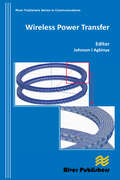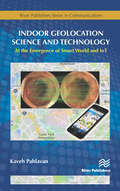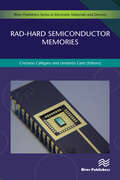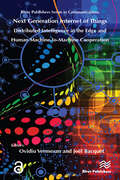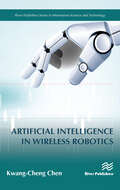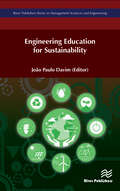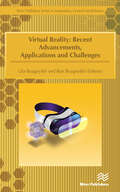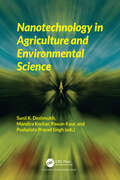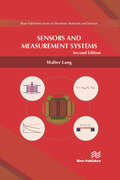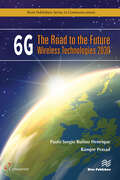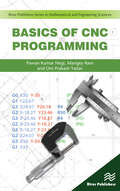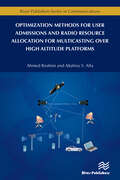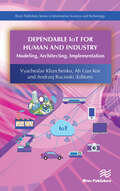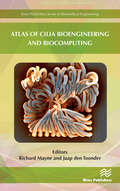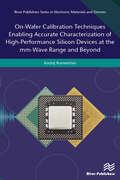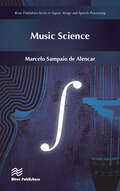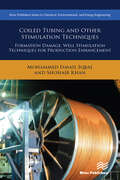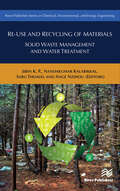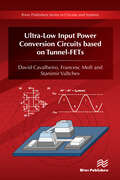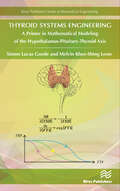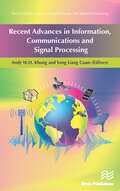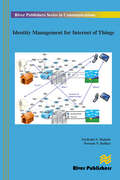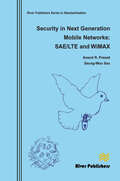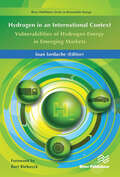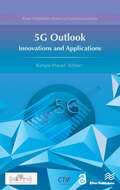- Table View
- List View
Wireless Power Transfer
Nikola Tesla's dream in the early 20th century of a "World Wireless System" led him to build the Wardenclyffe Tower, a prototype base station serving as an emitter for his "World Wireless System". The base station was to supply wireless electrical energy to a distant receiver. This book builds upon that dream and is a result of intensive research interest in powerline, machine to machine communications and wireless power transfer globally. Wireless energy transfer or Witricity (WIreless elecTRICITY) transfers electricity instead of data. The technology is useful in cases where instantaneous or continuous energy is needed but interconnecting wires are inconvenient, hazardous, or impossible. The transfer is made through inductive coupling and electromagnetic radiation. Inductive coupling provides optimum power delivery to a receiver load if both the emitter and the receiver achieve magnetic resonance concurrently. Energy transfer systems mostly use antennas operating in their near field regions. As fossil energy sources are being depleted rapidly worldwide and oil prices soar, solar energy enhanced with wireless power transfer (WPT) have become reasonable alternatives for renewable energy and power harvesting. They are finding use in transportation, electric and hybrid vehicles, very fast trains and the emerging field of Internet of Things. This book is written by the leading experts on wireless energy transfer technology and its applications. It introduces and explains the technology in great details and provides the theory and practice of WPT through the two approaches of coupled mode theory and circuit theory. Both approaches are dependent on resonance techniques. The level of presentation is suitable for design and training. In depth coverage is provided on near field concepts; coupled-mode theory and models; circuit models of inductive antennas; radiative and inductive wireless power transfer, wireless power relay concepts, optimization techniques for wireless power transfer systems, control of wireless power transfer systems, wireless charging concepts; wireless energy transfer applications in electric vehicles, embedded medical systems and propagation in human tissues. Each chapter is written by experts on a selected aspect of wireless energy transfer. The authors have gone to great lengths to provide worked examples to assist the reader in working through some of the difficult concepts and to allow more understanding. The book is an excellent foundation for applying wireless energy transfer technologies in most fields including transportation, communication, home automation, biomedical systems and home appliances. The book is recommended to practitioners and engineers in the power industry, students in universities and research institutes. Honours and post graduate students in Physics, electrical/electronic engineering and computer science will find the book easy to read and apply because of the mode of presentation.
Indoor Geolocation Science and Technology: at the Emergence of Smart World and IoT
by Kaveh PahlavanPrecise and accurate localization is one of the fundamental scientific and engineering technologies needed for the applications enabling the emergence of the Smart World and the Internet of Things (IoT). Popularity of localization technology began when the GPS became open for commercial applications in early 1990's. Since most commercial localization applications are for indoors and GPS does not work indoors, the discovery of opportunistic indoor geolocation technologies began in mid-1990's. Because of complexity and diversity of science and technology involved in indoor Geolocation, this area has emerged as its own discipline over the past two decades. At the time of this writing, received signal strength (RSS) based Wi-Fi localization is dominating the commercial market complementing cell tower localization and GPS technologies using the time of arrival (TOA) technology. Wi-Fi localization technology takes advantage of the random deployment of Wi-Fi devices worldwide to support indoor and urban area localization for hundreds of thousands of applications on smart devices. Public safety and military applications demand more precise localization for first responders and military applications deploy specialized infrastructure for more precise indoor geolocation. To enhance the performance both industries are examining hybrid localization techniques. Hybrid algorithms use a variety of sensors to measure the speed and direction of movement and integrate them with the absolute radio frequency localization. Indoor Geolocation Science and Technology is a multidisciplinary book that presents the fundamentals of opportunistic localization and navigation science and technology used in different platforms such as: smart devices, unmanned ground and flying vehicles, and existing cars operating as a part of intelligent transportation systems. Material presented in the book are beneficial for the Electrical and Computer Engineering, Computer Science, Robotics Engineering, Biomedical Engineering or other disciplines who are interested in integration of navigation into their multi-disciplinary projects. The book provides examples with supporting MATLAB codes and hands-on projects throughout to improve the ability of the readers to understand and implement variety of algorithms. It can be used for both academic education, as a textbook with problem sets and projects, and the industrial training, as a practical reference book for professionals involved in design and performance evaluation. The author of this book has pioneering research experience and industrial exposure in design and performance evaluation of indoor geolocation based on empirical measurement and modeling of the behavior of the radio propagation in indoor areas and inside the human body. The presentation of the material is based on examples of research and development that his students have performed in his laboratory, his teaching experiences as a professor, and his experiences as a technical consultant to successful startup companies.
Rad-hard Semiconductor Memories
by Cristiano Calligaro Umberto GattiRad-hard Semiconductor Memories is intended for researchers and professionals interested in understanding how to design and make a preliminary evaluation of rad-hard semiconductor memories, making leverage on standard CMOS manufacturing processes available from different silicon foundries and using different technology nodes.In the first part of the book, a preliminary overview of the effects of radiation in space, with a specific focus on memories, will be conducted to enable the reader to understand why specific design solutions are adopted to mitigate hard and soft errors. The second part will be devoted to RHBD (Radiation Hardening by Design) techniques for semiconductor components with a specific focus on memories. The approach will follow a top-down scheme starting from RHBD at architectural level (how to build a rad-hard floor-plan), at circuit level (how to mitigate radiation effects by handling transistors in the proper way) and at layout level (how to shape a layout to mitigate radiation effects).After the description of the mitigation techniques, the book enters in the core of the topic covering SRAMs (synchronous, asynchronous, single port and dual port) and PROMs (based on AntiFuse OTP technologies), describing how to design a rad-hard flash memory and fostering RHBD toward emerging memories like ReRAM. The last part will be a leap into emerging memories at a very early stage, not yet ready for industrial use in silicon but candidates to become an option for the next wave of rad-hard components. Technical topics discussed in the book include: Radiation effects on semiconductor components (TID, SEE) Radiation Hardening by Design (RHBD) Techniques Rad-hard SRAMs Rad-hard PROMs Rad-hard Flash NVMs Rad-hard ReRAMs Rad-hard emerging technologies
Next Generation Internet of Things – Distributed Intelligence at the Edge and Human-Machine Interactions
This book provides an overview of the next generation Internet of Things (IoT), ranging from research, innovation, development priorities, to enabling technologies in a global context. It is intended as a standalone in a series covering the activities of the Internet of Things European Research Cluster (IERC), including research, technological innovation, validation, and deployment.The following chapters build on the ideas put forward by the European Research Cluster, the IoT European Platform Initiative (IoT–EPI), the IoT European Large-Scale Pilots Programme and the IoT European Security and Privacy Projects, presenting global views and state-of-the-art results regarding the next generation of IoT research, innovation, development, and deployment.The IoT and Industrial Internet of Things (IIoT) are evolving towards the next generation of Tactile IoT/IIoT, bringing together hyperconnectivity (5G and beyond), edge computing, Distributed Ledger Technologies (DLTs), virtual/ andaugmented reality (VR/AR), and artificial intelligence (AI) transformation.Following the wider adoption of consumer IoT, the next generation of IoT/IIoT innovation for business is driven by industries, addressing interoperability issues and providing new end-to-end security solutions to face continuous treats.The advances of AI technology in vision, speech recognition, natural language processing and dialog are enabling the development of end-to-end intelligent systems encapsulating multiple technologies, delivering services in real-time using limited resources. These developments are focusing on designing and delivering embedded and hierarchical AI solutions in IoT/IIoT, edge computing, using distributed architectures, DLTs platforms and distributed end-to-end security, which provide real-time decisions using less data and computational resources, while accessing each type of resource in a way that enhances the accuracy and performance of models in the various IoT/IIoT applications.The convergence and combination of IoT, AI and other related technologies to derive insights, decisions and revenue from sensor data provide new business models and sources of monetization. Meanwhile, scalable, IoT-enabled applications have become part of larger business objectives, enabling digital transformation with a focus on new services and applications.Serving the next generation of Tactile IoT/IIoT real-time use cases over 5G and Network Slicing technology is essential for consumer and industrial applications and support reducing operational costs, increasing efficiency and leveraging additional capabilities for real-time autonomous systems.New IoT distributed architectures, combined with system-level architectures for edge/fog computing, are evolving IoT platforms, including AI and DLTs, with embedded intelligence into the hyperconnectivity infrastructure.The next generation of IoT/IIoT technologies are highly transformational, enabling innovation at scale, and autonomous decision-making in various application domains such as healthcare, smart homes, smart buildings, smart cities, energy, agriculture, transportation and autonomous vehicles, the military, logistics and supply chain, retail and wholesale, manufacturing, mining and oil and gas.
Artificial Intelligence in Wireless Robotics
by Kwang-Cheng ChenRobots, autonomous vehicles, unmanned aerial vehicles, and smart factory, will significantly change human living style in digital society. Artificial Intelligence in Wireless Robotics introduces how wireless communications and networking technology enhances facilitation of artificial intelligence in robotics, which bridges basic multi-disciplinary knowledge among artificial intelligence, wireless communications, computing, and control in robotics. A unique aspect of the book is to introduce applying communication and signal processing techniques to enhance traditional artificial intelligence in robotics and multi-agent systems.The technical contents of this book include fundamental knowledge in robotics, cyber-physical systems, artificial intelligence, statistical decision and Markov decision process, reinforcement learning, state estimation, localization, computer vision and multi-modal data fusion, robot planning, multi-agent systems, networked multi-agent systems, security and robustness of networked robots, and ultra-reliable and low-latency machine-to-machine networking. Examples and exercises are provided for easy and effective comprehension.Engineers wishing to extend knowledge in the robotics, AI, and wireless communications, would be benefited from this book. In the meantime, the book is ready as a textbook for senior undergraduate students or first-year graduate students in electrical engineering, computer engineering, computer science, and general engineering students. The readers of this book shall have basic knowledge in undergraduate probability and linear algebra, and basic programming capability, in order to enjoy deep reading.
Engineering Education for Sustainability
Understood to be a key issue in modern society, sustainability is characterized by its three essential pillars, namely: the environment, society and the economy. Education plays an important role in how people understand and accept sustainability. The integration of sustainability in engineering education is a relatively new phenomenon, and presenting information about engineering education for sustainability is of great interest to improve communication between professors, researchers and students at universities, institutes and research laboratories.Topics discussed in the book include: Experiences from 5 years of educating sustainability to computer science students Review of decision support methods in green and sustainable supply chains Analyzing the drivers of engineering education for sustainability using the MCDM approach Visualization technologies in construction education: a comprehensive review of recent advances A legal framework and compliance with construction safety laws and regulations
Virtual Reality: Recent Advancements, Applications and Challenges
Although the emergence of virtual reality (VR) goes back to the 1960s, with the recent availability of low-cost and high-accuracy systems it has become increasingly prevalent in a wide variety of areas; with uses ranging from training and education to rehabilitation and entertainment. Nowadays, there are many companies that have their own VR systems with various types of headsets and controllers. This has shaped how VR is being used today and how we interact with the latest generation VR systems. With the rapidly evolving dynamics gained through technological advancements, VR is projected to grow and transform the way humans do everyday tasks both in the workplace and in personal lives. In addition to the VR headsets, there are now augmented reality (AR) headsets that allow the user to see their real-world surroundings while also viewing computer generated imagery. This leads to an enhanced user experience. This book aims to provide a comprehensive update of the latest scientific research, mainly in VR and partly in AR, from the last five years. The content is themed around the application areas of training, education, robotics, health and well-being, and user experience.
Nanotechnology in Agriculture and Environmental Science
by Sunil K. Deshmukh Mandira Kochar Pawan Kaur Pushplata Prasad SinghThis book provides examples applications of nanotechnology in addressing problems and challenges in agriculture as well as environmental sciences and provides an overview of innovations in nanopesticides, nanofertilizers, bionanosensors and nano-based delivery system for improving different aspects of plant productivity including pre-harvest and post-harvest strategies as well detection of contaminants that could be useful for enhancing soil health. Recycling of agricultural waste to beneficial products using nanotechnologies; bionanosensors; fate of nanomaterials and the ecological consequences of their delivery into the environment; safety and nanotoxicity issues are other topics being dealt with in this book. Chapters have been written by internationally recognized researchers and experts with special reference to the innovations and latest developments in the mentioned areas of nanobiotechnology that have applications and commercial importance, especially for crop fields and post-harvest management. Despite the research and development used to promote the use of nanotechnology in agriculture and the environmental, knowledge gaps and uncertainties about how to fill the gaps are more prevalent than scientific certainties about the public health and environmental effects of nanomaterials. The book thus addresses the issue of toxicity of nanomaterials in agricultural nanotechnology products. The book will be useful for active researchers and scientists in the agricultural sector, academia as well as industry, including nanotechnologists, plant pathologists, agronomists, agrochemists, environmental technologists and all scientists working for sustainability in agriculture. The book will encourage future and active researchers and scientists in the agriculture sector, academia as well as industry.
Sensors and Measurement Systems
by Walter LangSensors and measurement systems is an introduction to microsensors for engineering students in the final undergraduate or early graduate level, technicians who wants to know more about the systems they are using, and anybody curious enough to know what microsystems and microsensors can do. The book discusses five families of sensors: - Thermal sensors - Force and pressure sensors- Inertial sensors - Magnetic field sensors- Flow sensorsFor each sensor, theoretical, technology and application aspects are examined. The sensor function is modelled to understand sensitivity, resolution and noise. We ask ourselves: What do we want to measure? What are possible applications? How are the sensor chips made in the cleanroom? How are they mounted and integrated in a system?After reading this book, you should be able to:- Understand important thermal, mechanical, inertial and magnetic sensors- Work with characterization parameters for sensors- Choose sensors for a given application and apply them- Understand micromachining technologies for sensors
6G: The Road to the Future Wireless Technologies 2030
by Paulo Sergio Henrique Ramjee PrasadSince the launch of Second-Generation Networks (2G), planning for each future mobile service was initiated many years before its commercial launch. In 2019, 5G Networks begun to be deployed commercially after almost ten years of planning. Similarly, the race for the 6G wireless networks that will be operational in 2030 has already started. To fulfill its potential in the upcoming decade, 6G will undoubtedly require an architectural orchestration based on the amalgamation of existing solutions and innovative technologies. The book will begin by evaluating the state of the art of all current mobile generations' while looking into their core building blocks. 6G implementation will require fundamental support from Artificial Intelligence (AI) and Machine Learning on the network's edge and core, including a new Radio Frequency (RF) spectrum. The 6G use cases will require advanced techniques for enabling the future wireless network to be human-centric, ensuring enhanced quality of experience (QoE) for most of its applications. The concept of Human Bond Communication Beyond 2050 (Knowledge Home) and Communication, Navigation, Sensing, and Services (CONASENSE) will also profit from future wireless communication. Terahertz domains will exploit the ultra-Massive Multiple Input Multiple Output Antennas (UM-MIMO) technologies to support Terabits' data throughputs.Moreover, optical wireless communications (OWC) will also come into play to support indoor and outdoor high-data rates. Further expansion of 6G core entities will support the novel concept of Society 5.0. Quantum computing processing and communications is also likely to be added into the 6G ecosystem with security managed by blockchain orchestration for a robust network.
Basics of CNC Programming
by Pawan Negi Mangey Ram Om Prakash YadavBefore the introduction of automatic machines and automation, industrial manufacturing of machines and their parts for the key industries were made though manually operated machines. Due to this, manufacturers could not make complex profiles or shapes with high accuracy. As a result, the production rate tended to be slow, production costs were very high, rejection rates were high and manufacturers often could not complete tasks on time.Industry was boosted by the introduction of the semi-automatic manufacturing machine, known as the NC machine, which was introduced in the 1950’s at the Massachusetts Institute of Technology in the USA. After these NC machine started to be used, typical profiles and complex shapes could get produced more readily, which in turn lead to an improved production rate with higher accuracy.Thereafter, in the 1970’s, an even larger revolutionary change was introduced to manufacturing, namely the use of the CNC machine (Computer Numerical Control). Since then, CNC has become the dominant production method in most manufacturing industries, including automotive, aviation, defence, oil and gas, medical, electronics industry, and the optical industry. Basics of CNC Programming describes how to design CNC programs, and what cutting parameters are required to make a good manufacturing program. The authors explain about cutting parameters in CNC machines, such as cutting feed, depth of cut, rpm, cutting speed etc., and they also explain the G codes and M codes which are common to CNC. The skill-set of CNC program writing is covered, as well as how to cut material during different operations like straight turning, step turning, taper turning, drilling, chamfering, radius profile, profile turning etc. In so doing, the authors cover the level of CNC programming from basic to industrial format. Drawings and CNC programs to practice on are also included for the reader.
Optimization Methods for User Admissions and Radio Resource Allocation for Multicasting over High Altitude Platforms
by Ahmed Ibrahim Attahiru AlfaThis book focuses on the issue of optimizing radio resource allocation (RRA) and user admission control (AC) for multiple multicasting sessions on a single high altitude platform (HAP) with multiple antennas on-board. HAPs are quasi-stationary aerial platforms that carry a wireless communications payload to provide wireless communications and broadband services. They are meant to be located in the stratosphere layer of the atmosphere at altitudes in the range 17-22 km and have the ability to fly on demand to temporarily or permanently serve regions with unavailable telecommunications infrastructure. An important requirement that the book focusses on is the development of an efficient and effective method for resource allocation and user admissions for HAPs, especially when it comes to multicasting. Power, frequency, space (antennas selection) and time (scheduling) are the resources considered in the problem over an orthogonal frequency division multiple access (OFDMA) HAP system.Due to the strong dependence of the total number of users that could join different multicast groups, on the possible ways we may allocate resources to these groups, it is of significant importance to consider a joint user to session assignments and RRA across the groups. From the service provider's point of view, it would be in its best interest to be able to admit as many higher priority users as possible, while satisfying their quality of service requirements. High priority users could be users subscribed in and paying higher for a service plan that gives them preference of admittance to receive more multicast transmissions, compared to those paying for a lower service plan. Also, the user who tries to join multiple multicast groups (i.e. receive more than one multicast transmission), would have preferences for which one he would favor to receive if resources are not enough to satisfy the QoS requirements.Technical topics discussed in the book include: • Overview on High Altitude Platforms, their different types and the recent works in this area Radio Resource Allocation and User Admission Control in HAPs Multicasting in a Single HAP System: System Model and Mathematical Formulation Optimization schemes that are designed to enhance the performance of a branch and bound technique by taking into account special mathematical structure in the problem formulation
Dependable IoT for Human and Industry: Modeling, Architecting, Implementation
There are numerous publications which introduce and discuss the Internet of Things (IoT). In the midst of these, this work has several unique characteristics which should change the reader’s perspective, and in particular, provide a more profound understanding of the impact of the IoT on society. Dependable IoT for Human and Industry covers the main aspects of Internet of Things and IoT based systems such as global issues of applications, modeling, development and implementation of dependable IoT for different human and industry domains. Technical topics discussed in the book include: Introduction in Internet of vital and trust Things Modelling and assessment techniques for dependable and secure IoT systems Architecting and development of IoT systems Implementation of IoT for smart cities and drone fleets; business and blockchain, transport and industry Training courses and education experience on Internet and Web of ThingThe book contains chapters which have their roots in the International Conference IDAACS 2017, and Workshop on Cyber Physical Systems and IoT Dependability CyberIoT-DESSERT 2017.
Atlas of Cilia Bioengineering and Biocomputing
Cilia are microscopic finger-like cell-surface organelles possessed by a great many eukaryotic organisms, including humans, whose purposes include generating local fluid movements via rhythmic whip-like beating and environmental sensing. Despite intense research efforts since their discovery by van Leeuwenhoek in the 1670's, several key questions regarding ciliary functions, experimental manipulation and in silico imitation remain unanswered. Major justifications for cilia research lie in their involvement in various forms of human disease (ciliopathies) and their ability to instantiate decentralised, asynchronous sensorial-actuation of adjacent matter through modulation of beating characteristics. Further elucidation of these characteristics, which is a problem requiring the combined expertise of mathematicians, computer scientists, engineers and life scientists, will lead to novel biomedical therapies, creation of `smart' actuating surfaces for microfluidics/lab-on-chip applications and a greater understanding of fluid mechanics in real-world scenarios. This lavishly-illustrated anthology presents recent advances in the fields of ciliary investigation, manipulation, emulation, mimesis and modelling from key researchers in their fields: its goal is to explain the state-of-the-art in cilia bioengineering and bio-computation in a uniquely creative, accessible manner, towards encouraging further transdisciplinary work in the field as well as educating a broad spectrum of scientists and lay people. The volume is split into three distinct but interwoven themes:Biology: Biological preliminaries for the study of cilia; the state-of-the-art in genetic engineering of ciliated cells for biomedical purposes; reprogramming of cilia dynamics in live cells.Engineering: Creation of macro cilia robots for object sorting applications; pneumatic cilia for the optimization of fluid motion; electrostatic, magnetic and MEMS cilia for microfluidic mixing; reviews in artificial cilia fabrication, actuation and flow induction methods.Numerical and computational modelling. Analyses of thin film cilia for `lab on chip' microfluidic mixing applications; modelling of gel-based artificial cilia towards simulating dynamic behaviors of responsive cilia layers in complex fluids across a wide range of potential applications.
On-Wafer Calibration Techniques Enabling Accurate Characterization of High-Performance Silicon Devices at the mm-Wave Range and Beyond
by Andrej RumiantsevThe increasing demand for more content, services, and security drives the development of high-speed wireless technologies, optical communication, automotive radar, imaging and sensing systems and many other mm-wave and THz applications. S-parameter measurement at mm-wave and sub-mm wave frequencies plays a crucial role in the modern IC design debug. Most importantly, however, is the step of device characterization for development and optimization of device model parameters for new technologies. Accurate characterization of the intrinsic device in its entire operation frequency range becomes extremely important and this task is very challenging.This book presents solutions for accurate mm-wave characterization of advanced semiconductor devices. It guides through the process of development, implementation and verification of the in-situ calibration methods optimized for high-performance silicon technologies.Technical topics discussed in the book include: Specifics of S-parameter measurements of planar structures Complete mathematical solution for lumped-standard based calibration methods, including the transfer Thru-Match-Reflect (TMR) algorithms Design guideline and examples for the on-wafer calibration standards realized in both advanced SiGe BiCMOS and RF CMOS processes Methods for verification of electrical characteristics of calibration standards and accuracy of the in-situ calibration results Comparison of the new technique vs. conventional approaches: the probe-tip calibration and the pad parasitic de-embedding for various device types, geometries and model parameters New aspects of the on-wafer RF measurements at mmWave frequency range and calibration assurance.
Music Science
by Marcelo Sampaio AlencarThe book presents the fundamentals of music science, followed by a discussion on the historical evolution of music. An introduction to the analysis of signals in time and frequency is presented, which includes sound and noise. Features and mathematical aspects of the sound are discussed, including vibration and timbre.The book presents a review of existing voice models and discusses the voice production, sound perception, music characteristics and acoustics, tempo, rhythm and harmony. Musical theory is presented, including staff, notes, alterations, keys and intervals, tones and associated frequencies and wavelengths. The creation of major and minor scales is emphasized, along with a study on consonance and dissonance, measure, metric, tempo markings, dynamics, modulation. The book also explains the chord formation, and discusses melody and composition.The book has four appendices, including an appendix on the basic differentiation and integration theorems, another with useful Fourier tables, and an appendix featuring the notes, their frequencies and wavelengths. The book also has a glossary of music terms.
Coiled Tubing and Other Stimulation Techniques: Formation Damage, Well Stimulation Techniques for Production Enhancement
by Mohammed Ismail IqbalGood engineers never stop looking for opportunities to improve the performance of their production systems. Performance enhancement methods are always carefully examined, and production data is analyzed in order to identify determining factors affecting performance.The two main activities of the production engineer in the petroleum and related industries are reservoir stimulation and artificial lift. The classic solution to maximizing a well's productivity is to stimulate it. The basis for selecting stimulation candidates should be a review of the well's actual and theoretical IPR. Low permeability wells often need fracturing on initial completion. In low permeability zones, additional post stimulation production can be significant to the economics, however, the production engineer needs to make management aware of the true long term potential or else overly optimistic projections can easily be made.The main purpose of stimulation is to enhance the property value by the faster delivery of the petroleum fluid and/or to increase ultimate economic recovery. The aim of reservoir stimulation is to bypass near-wellbore damage and return a well to its “natural” productivity / injectivity, to extend a conductive path deep into a formation and thus increase productivity beyond the natural level and to produce hydrocarbon from tight formation.The importance of reservoir stimulation is increasing due to following reasons: • Hydrocarbon fields in their mid-life• Production in these fields are in declining trend• The thrust area: Enhancement of productionHence, to improve productivity of the well matrix stimulation and hydraulic fracturing are intended to remedy, or even improve, the natural connection of the wellbore with the reservoir, which could delay the need for artificial lift.This book presents procedures taken in the Oil & Gas Industry for identifying well problems, and it suggests means of solving problems with the help of the Coil Tube unit which is used for improving well productivity and techniques like Acidizing and Hydraulic Fracturing.
Re-Use and Recycling of Materials: Solid Waste Management and Water Treatment
by Jibin K. P. Nandakumar Kalarikkal Sabu Thomas Ange NzihouIn recent years, a considerable amount of effort has been devoted, both in industry and academia, towards the recycling and reuse of materials. Most nations are now trying to reduce the amount of waste materials, through the proper recycling of materials.Re-Use and Recycling of Materials will help readers to understand the current status in the field of waste management, as well as what research is taking place to deal with such issues.Technical topics discussed in the book include: Municipal solid waste management Recycling of WEEE Waste to industrially important product like lignin and cellulose Recycling of agriculture waste Polymer and plastic recycling
Ultra-Low Input Power Conversion Circuits based on Tunnel-FETs
by David Cavalheiro Francesc Moll Stanimir ValtchevThe increasing demand in electronic portability imposes low power consumption as a key metric to analog and digital circuit design. Tunnel FET (TFET) devices have been explored mostly in digital circuits, showing promising results for ultra-low power and energy efficient circuit applications. The TFET presents a low inverse sub-threshold slope (SS) that allows a low leakage energy consumption, desirable in many digital circuits, especially memories.In this book, the TFET is explored as an alternative technology also for ultra-low power and voltage conversion and management circuits, suitable for weak energy harvesting (EH) sources. The TFET distinct electrical characteristics under reverse bias conditions require changes in conventional circuit topologies. In this book, ultra-low input power conversion circuits based on TFETs are designed and analyzed, evaluating their performance as rectifiers, charge pumps and power management circuits (PMC) for RF and DC EH sources.
Thyroid Systems Engineering: A Primer in Mathematical Modeling of the Hypothalamus-Pituitary-Thyroid Axis
by Simon Goede Melvin Khee-Shing LeowIn recent years, a considerable amount of effort has been devoted, both in industry and academia, towards the behavioral modeling, evaluation and prediction of the hypothalamus pituitary thyroid system.Thyroid Systems Engineering targets an optimal treatment of people suffering from thyroid hormone disorders. The content is motivated by in-depth observations of such patients whose rich data supported the theoretical framework arising from formal mathematical reasoning, guided by the nature of thyroid physiology. Leveraging on the insights emerging from the unique combination of an electrical engineer working with a clinical thyroidologist, and both being scientists skilled in mathematics, the authors introduce this new discipline and field of scientific investigation aptly designated as Thyroid Systems Engineering.Readers will discover that mathematics can indeed model the behavior of the hypothalamus-pituitary-thyroid (HPT) axis. Focused on modeling, each of the eighteen chapters gives the reader a notion of the application of relevant mathematics to pertinent issues encountered in mainstream thyroidology. Many cellular processes resemble the flux of variables and states in a complex multi-parameter space through time analogous to current flow in electrical networks. It is then logical to apply the principles and physical laws of electrodynamics, electrical network theory, control systems theory and signal theory to many of the biological phenomena encountered in endocrinology. Such an approach is used liberally throughout the book and successfully yields elegant solutions to a number of models presented within.This book can serve as a reference to mathematical modeling in other aspects of endocrine physiology, and as the starting point for a fundamental course in medical modeling. It will appeal to postgraduates in electrical engineering, academic physicians and biomedical researchers. Further, readers equipped with advanced calculus, electrical network theory, control theory and signal theory should be able to follow the mathematical expositions that describe thyrotropic control. They represent a new discipline based on mathematical modeling in physiology applicable to medical diagnostics, measurement and treatment to cooperate in the clinical team and realize an optimized treatment for patients.
Recent Advances in Information, Communications and Signal Processing
by Andy W. H. Khong Yong Liang GuanResearch in information, communications and signal processing has brought about new services, applications and functions in a large number of fields which include consumer electronics, biomedical devices and defence. These applications play an important role in advancing technologies to enhance human life in general. Recent Advances in Information, Communications and Signal Processing aims to give students, researchers, and engineers information pertaining to recent advances in these fields. In terms of research in signal processing topics, the two chapters included in this book have a strong emphasis on advances in algorithmic development in the biomedical, and human-computer interfaces domain areas. More specifically, the use of deep learning for placental maturity staging is discussed as well as the use of vibration analysis for localising impacts on surfaces for human-computer applications. In terms of communications signal processing, advances in new wireless communication such as NOMA (non-orthogonal multiple access) and millimetre-wave antenna design for 5G cellular mobile radio, as well as innovations in LDPC (low density parity check code) decoding and networking coding, are featured.
Identity Management for Internet of Things
by Parikshit N. Mahalle Poonam N. RailkarThe Internet of Things is a wide-reaching network of devices, and these devices can intercommunicate and collaborate with each other to produce variety of services at any time, any place, and in any way. Maintaining access control, authentication and managing the identity of devices while they interact with other devices, services and people is an important challenge for identity management. The identity management presents significant challenges in the current Internet communication. These challenges are exacerbated in the internet of things by the unbound number of devices and expected limitations in constrained resources. Current identity management solutions are mainly concerned with identities that are used by end users, and services to identify themselves in the networked world. However, these identity management solutions are designed by considering that significant resources are available and applicability of these identity management solutions to the resource constrained internet of things needs a thorough analysis. Technical topics discussed in the book include:• Internet of Things;• Identity Management;• Identity models in Internet of Things;• Identity management and trust in the Internet of Things context;• Authentication and access control;Identitymanagement for Internet of Things contributes to the area of identity management for ubiquitous devices in the Internet of Things. It initially presents the motivational factors together with the identity management problems in the context of Internet of Things and proposes an identity management framework. Following this, it refers to the major challenges for Identitymanagement and presents different identity management models. This book also presents relationship between identity and trust, different approaches for trust management, authentication and access control.
Security in Next Generation Mobile Networks: SAE/LTE and Wimax (River Publishers Series In Standardisation Ser.)
by Anand R. Prasad Seung-Woo SeoStarting from voice services with simple terminals, today a mobile device is nothing sort of a small PC in the form of smart-phones. The result has been a huge increase in data-services giving mobile communication access to critical aspects of human society / life. This has led to standardization of SAE/LTE (System Architecture Evolution / Long Term Evolution) by 3GPP and IEEE 802.16e / WiMAX. Together with penetration of mobile communications and new standardization come new security issues and thus the need for new security solutions. This book provides a fresh look at those security aspects, with main focus on the latest security developments of 3GPP SAE/LTE and WiMAX. SAE/LTE is also known as Evolved Packet System (EPS).The intended audience for this book is mobile network and device architects, designers, researchers and students. The goal of the authors, who have a combined experience of more than 25 years in mobile security standardization, architecture, research, and education, is to provide the book?s readers with a fresh and up-to-date look at the architecture and challenges of EPS and WiMAX security.
Hydrogen in an International Context: Vulnerabilities of Hydrogen Energy in Emerging Markets
by Ioan IordacheHydrogen in an International Context: Vulnerabilities of Hydrogen Energy in Emerging Markets describes strategies and developments for hydrogen civilization efforts realised by various stakeholders such as authorities, institutes, research, industry, and individuals, in different countries and at different stages of the development cycle. Through their contributions, the chapter authors in this book propose a new approach to actual and relevant topics of interest, generically called the hydrogen economy and civilization.Hydrogen vulnerabilities is a topic that includes new challenges that face the hydrogen energy market. Weaknesses for the hydrogen stakeholder are becoming more refined, and it is necessary to be an active and sensitive player to understand these. A prosperous development of hydrogen will require the assimilation of numerous, diverse and unfamiliar contexts. Challenges for hydrogen will not only be in scientific, technical, economical or public acceptance, but challenges also lie in the genesis of this topic and the neglect of some aspects, however marginal, which negatively influence the desired hydrogen developed.This book informs the reader about the status of hydrogen energy in the international market, and it includes a series of examples and case studies about hydrogen activities in various countries. Thus, due to the synergy of this library of contexts, the reader should be able to reach a level of intuition enabling them to see the strengths and weaknesses of hydrogen.
5G Outlook – Innovations and Applications
by Ramjee Prasad5G Outlook - Innovations and Applications is a collection of the recent research and development in the area of the Fifth Generation Mobile Technology (5G), the future of wireless communications. Plenty of novel ideas and knowledge of the 5G are presented in this book as well as divers applications from health science to business modeling. The authors of different chapters contributed from various countries and organizations. The chapters have also been presented at the 5th IEEE 5G Summit held in Aalborg on July 1, 2016. The book starts with a comprehensive introduction on 5G and its need and requirement. Then millimeter waves as a promising spectrum to 5G technology is discussed. The book continues with the novel and inspiring ideas for the future wireless communication usage and network. Further, some technical issues in signal processing and network design for 5G are presented. Finally, the book ends up with different applications of 5G in distinct areas. Topics widely covered in this book are: • 5G technology from past to present to the future• Millimeter- waves and their characteristics• Signal processing and network design issues for 5G• Applications, business modeling and several novel ideas for the future of 5G
